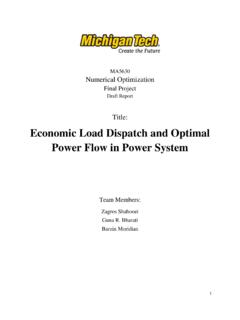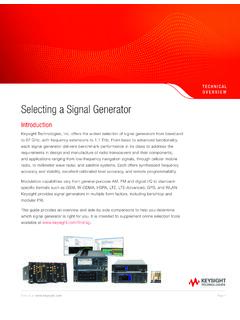Transcription of 802.15.4/4z UWB Technology Challenges and Test Solutions
1 Project Manager / Keysight TechnologiesTIM UWB Technology Challenges and Test Solutions201 Ultra Wide-Band StandardEvolution & Ecosystem02 Overview of IEEE Test Challenges and UWB TECHNOLOGY3WI-F I , B L U E T O O T H , R F I D A N D U W BThe benefit of UWB, is in its low-power pulses, which help to ensure security and allow for highly accurate location (Wi-Fi based)Bluetooth LE ( )RFIDUWBS tandardsIEEE WLAN SIGEPC/ISOIEEE WPAN of the received signal (RSSI)RSSI (Mesh)AoAor AoDRemote couplingAoAor ToFSecureUnder relay attack threatUnder relay attack threatHIGH SecurityHIGH , 5, 6 GHz GHz125 KHzto GHzSub-GHzLow band ( to GHz)High band (6 to GHz)ModulationOFDMGFSKASK/2 FSK/OOKBPM+BPSK ( )HRP-ERDEV (BPRF, HPRF)Trans.
2 Range< 150 meters< 75 meters< 1 meter< 100 metersAccuracy< 15 meters< 1 meter ( )< 8 meters ( )Presence detection only< 30 cm (objects down to less than 10 cm in line of sight)Power ConsumptionHighLowPassive poweredMedium / LowCost$$$$$$$$$4 FCC Definition: An intentional radiator that has either: A fractional bandwidth (Bfrac) greater than whereBfrac= BW / fc A bandwidth greater than or equal to 500 MHzThe frequency upper and lower bounds (FHand FL respectively) are the points that are 10 dB below the highest radiated power part of the = (FH-FL)Fc = 1/2 * (FH+ FL)Bfrac= B / Fc = 2*(FH-FL)/ (FH+ FL) In an unlicensed band with a very strict power spectral density of dBm/MHzU L T R A W I D E-B A N DHRP UWB Solution5D E F I N E D I N I E E E 2007 Completed in Aug.
3 , 2007 1ststandardization of UWB Evolved from OFDM-based to use impulse radio (UWB-IR), 2ns pulse width Indoor positioning for WSN or 2011 Completed in Sep., 2011 Decawavechipset based on this spec on 2015 Completed in Dec., 2015 2 UWB PHY Defined:(1) HRP (High Rate Pulse) from (2) LRP (Low Rate Pulse) as (aka Active RFID) 2019 Active working group (TG4z) Enhancements of Security extension to HRP & LRP UWB PHYs & MAC Introduce ERDEV (Enhanced Ranging Device) mode including BPRF or HPRFHRP UWB Solution6C H I P S E T, D E V I C E , A P P L I C A T I O N , C O N S O R T I U MHRP UWB SolutionChipsets / Modules USA Europe Korea ChinaDevices Mobile Phone Car Key Car More comingApplications Smart Home Mobile Payment Keyless/ Car Entry Indoor navigationConsortiums UWB Allianceformed in Dec.
4 , 2018 FiRAformed in Aug., 0 1 5 H R P U W B P H YISMBand Sub-GHz band: MHz to MHz 1 channel with 500 MHz BW Channel #0 as mandatory Low band: GHz to GHz 4 channels 3 channels with 500 MHz BW 1 channel with BW Channel #3 as mandatory High band: GHz to GHz 11 channels 8 channels with 500 MHz BW 1 channel with BW 2 channels with BW Channel #9 as mandatorySource: NXPIEEE -HRP PHY band allocation (blue channels have MHz bandwidth, others as notedSource: 0 1 5 H R P U W B P H YBand GroupChannel NumberCenter Freq (MHz)Bandwidth (MHz)(-3dB BW)Mandatory/Optional0 (Sub-GHz) below 1 GHz1 Low band ( GHz to GHz) in low High band (6 GHz to GHz) in high 0 1 5 H R P U W B P H YTransmitted at different rates.)
5 SHR: base rate 1 MSym/s (16/64 MHz PRF), (4 MHz PRF) PHR: 110kbps, 850kbps Data: information data rate (110/850kbps, )HRP UWB SolutionPhysical frame is composed of three parts: SYNC field, physical header (PHR) and Payload (dataField). SYNC field is further split into two parts: the preamble and start of frame delimiter (SFD). UWB physical frame structure 10 This amendment enhances the UWB PHYs with additional coding and preamble options, improvements to existing modulations to increase the integrity and accuracy of the ranging measurements, additional information element definitions to facilitate ranging information exchange. It also enhances the MAC to support control of time of flight ranging procedures and exchange ranging related information between the participating ranging devices.
6 To reduce air-time for higher density/lower power operation To increase the integrity and accuracy of ranging measurement timestamps Typical range of the radio is up to 100 metersERDEV BPRF mode (Base PRF mode, nominal 64 MHz PRF) HPRF mode(256 MHz PRF, 128 MHz PRF)HRP UWB SolutionE R D E V ( E N H A N C E D R A N G I N G-C A P A B L E D E V I C E )( )( )11 Optional Title of the PresentationThe 128 pulses of the STS are generated from AES-128. : It will only be correctly received (correctly correlated in the receiver) when both TX and RX parties know the keys. It is secure against both accidental interference and intentional malicious R D E V F O R M AT SAn HRP UWB PHY based ERDEV which includes STS (Scrambled Timestamp Sequence)to increase the integrity and accuracy of ranging N D O O R P O S I T I O N I N G S E R V I C E SHRP UWB Solution UWB offers a high-precisionpositioning, even in crowded, multipath signal environments, and can pass obstacles.
7 Positioning with RSSI can be hacked and encryption can be broken. Time of Flight technique is difficult to fake time. Advantage: highest precision and positional stability How it works: The anchors send UWB signals, the sensors return them. The distance is calculated based on the time it takes the pulses between sending and : NXPS ecurity13S I N G L E-S I D E D T W O-W AY R A N G I N G( S S-T W R ) A initiates the exchange and device B responds. Each device precisely timestamps the transmissionand receptiontime of the message frames, and so cancalculate times Troundand Treplyby simple subtraction. Time of Flight Tpropis the propagation time of the RMARKER between the devices. For the TOF to be calculated at device A, device A needs the reply time Treplyemployed by device is determined by device B after its transmission,an additional message is necessary to bring this value to device can be accurately predicted by device B before its transmission, the value can be embedded in the replymessage itself.
8 HRP UWB SolutionT0T3T1T2 Distance = Tpropx Speed of light14DS-T W R Double-sided two-way ranging (DS-TWR) with four messages A initiates -> B responds -> B initiates ->A responds Double-sided two-way ranging (DS-TWR) with three messages T0T3T5T6T1T2T4T715R E Q U I R E M E N T SHRP UWB SolutionHigh band operating in 6 GHz to GHz> 6 GHz FrequencyWide bandwidth at least 500 MHz, up to > 500 MHz BWMeet RF requirements in PHY SpecIEEE Signal Generation and Analysis Solutions17D E F I N E D I N I E E E 8 0 2 . 1 5 . 4 Required HRP UWB Transmitter Measurements Tx Maximum allowable output PSD comply to regulatory requirements (FCC: < @3-10 GHz) Tx Transmit PSD mask: Less than 10 dB relative to the maximum spectral density of the signal for < |f fc| < Less than 18 dB for |f fc| > Tpis the inverse of the chip Wideband TransceiverE7760A Wideband Transceiver 1 VSA, 1 VSG in 2U form factor saves precious rack space Analysis and Generation Bandwidth: 2 GHz 2x IFIO ports(SMA): 2 18 GHz 6x RF ports (Type N): 55 -68 GHz for mmWaveTransceivers (M1650A) Built-in Windows PC controller Signal Studio waveform Playback (E7760A-CG1 is required) Connectivity with 89601 VSAP erformance Analyzeramplitude range -90 dBm to +10 dBm.
9 Generator settable output power range: -60 dBm to +7 dBm Linearity: + dB IQ data capture depth and ARB waveform memory: 1G SamplesIFIOHRP UWB Solution19 HRP-UWB support (IoT 2020): Support Non-HRP-ERDEV ( ), HRP-ERDEV BPRF and HPRF ( ) Support all channel 0-15 Header settings: preamble code index, symbols, Delta length PSDU settings with Viterbi Rate, Hop Bursts, Chirp Per Burst and Physical payload settings Impairment settings: Symbol timing error and freqoffset Supported hardware: E7760A wideband transceiver PXIe VXG M9383B/M9384B AWG M8190A + PSG E8267 DHRP UWB SolutionH R P U W BS I G N A L G E N E R AT I O NChoose HRP UWB modesConfigure HeaderConfigure PSDUC onfigure impairmentConfigure Milti-path20E 7 7 6 0 A , X-S E R I E S N 9 0 X 0 B XSAE7760A Wideband Transceiver One-Box Tester Platform for both DVT or MFG signal generation and analysis Cover 2 IF input/output ports from 2 to 18 GHz and up to RF input/output ports from 55 to 68 GHz connecting the M1650A mmWavetransceiver Internal analysis bandwidth up to 2 GHz Connectivity with 89600 VSA and support UWB signal analysis (option 89601 BHTC)
10 M9383B/M9384B Microwave signal generators Dual-channel 1 MHz to 44 GHz VSG with up to 2 GHz bandwidth. M9384B is an integrated box with touch-front panel M9383B is the PXIe modular without front-panel AWG M8190A as the baseband signal generator with variable sample rate from 125 MSa/s to 8/12 GSa/s and spurious-free-dynamic range (SFDR) up to 90 dBc(typ.) AWG M8190A has up to 2 GSaarbitrary waveform memory per channel and analog bandwidth up to 5 GHz Vector PSG as the up-converter up to to 44 GHz with 80 MHz internal BW and 4 GHz BW as external I/Q inputAWG M8190A + PSGE8267 DHRP UWB Solution21 89600 VSA supports all modes: Non-HRP-ERDEV in IEEE HRP-ERDEV-BPRF and HRP-ERDEV-HPRF in IEEE Key features Support sub-GHz, L-band ( GHz) and H-band ( GHz) Support all bandwidth.






